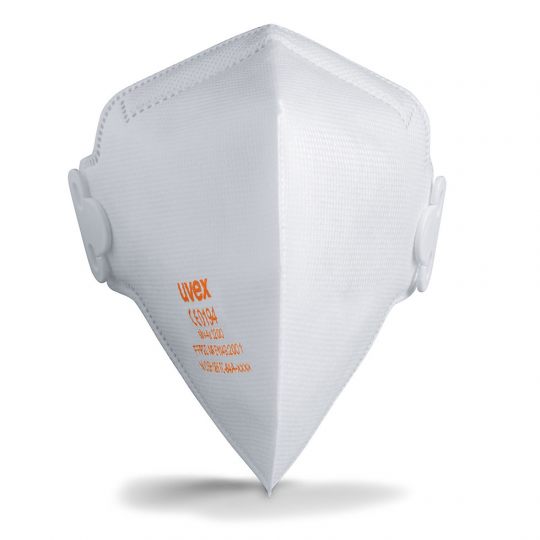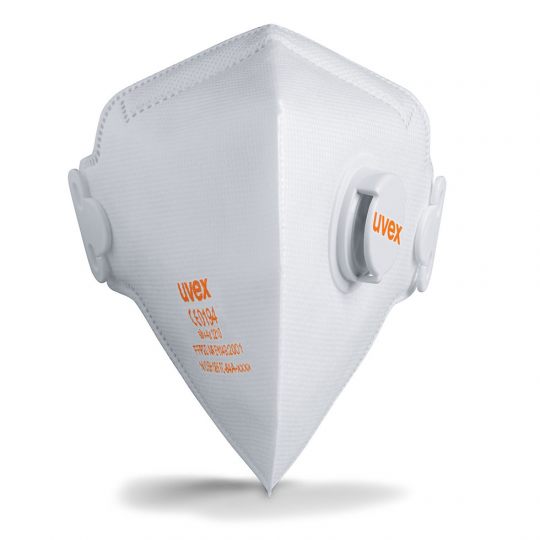Respirator masks & P2 dust masks
Welcome to uvex safety Australia & New Zealand experts in respirator masks.The uvex silv-Air range of respiratory protection includes highly effective respirator mask in protective class P2 that are extremely comfortable to wear. Protect yourself against solid and liquid aerosols, dust, mist and smoke – even during longer periods of use.
FILTER
- Construction and related trades – roof insulation: glass and mineral fibres
- Construction and related trades – masonry: cutting, drilling, demolition
- Construction and related trades – putty/filler: sanding
- Construction and related trades: cement work, plastering, tiling, roofing
- Disposal/cleaning: sweeping of floors
- 360° exhalation valve
- Carbon inside
- D marked
- Packed individually
- Comfort sealing lip around the nose
FAQ Respiratory and Breathing Protection
Respiratory protection products fall under PPE category iii, which means that the products provide protection against irreparable damage/disease and death. Because of this, training is mandatory for products in this category. The training covers aspects such as how to correctly fit and remove the respirator.
The employer is responsible both for selecting an appropriate respirator and for organizing the training.
Mouth and nose masks are often referred to as surgical masks. They are designed to prevent droplets and bodily fluids excreted by the wearer from being transmitted into the environment. However, these masks do not provide sufficient protection for the wearer. Unlike respiratory protection products designed in line with EN149, these masks are not considered personal protective equipment. uvex masks are primarily designed to protect the wearer, which is why factors such as achieving a close fit are incredibly important. uvex respirators are capable of filtering out the smallest particles and droplets from the ambient air to provide reliable protection for the wearer. uvex focuses on the manufacture of personal protective equipment. For this reason, our range only includes respirators that satisfy European Standard EN149; we do not sell surgical masks.
Particle-filtering respirators provide protection against particles but not against gases or vapours. These masks are usually made entirely of multiple layers of filter material and may be fitted with an exhalation valve.
The various layers all fulfil a different purpose, from improving the look and feel of the mask to ensuring strength, tear resistance and filtration.
One of the most important aspects of comfort for wearers of respirators is breathing resistance, which refers to the resistance that the wearer feels when breathing in and out – the higher the resistance, the harder the wearer’s lungs have to work.
To keep breathing resistance low, the filter material must be air-permeable on one side while still filtering particles on the other. For this reason, the filter material is electrostatically charged. This allows small particles that are actually small enough to pass through the filter material to stick to it.
According to the Robert Koch Institute, the most important and effective ways to protect yourself are: “Self-isolation if you are ill, practising good hand hygiene, complying with rules relating to coughs and sneezes and practising social distancing (staying at least 1.5 metres away from others)”. If you are treating a patient, the authorities recommend other measures, including wearing a close-fitting, multi-layer mouth and nose mask.
The minimum recommended protection level for respiratory protection is FFP2 (based on the European standard) or N95 (based on the American standard) or AS/NZS 1716 (based on the Australian standard).
Masks in protection categories FFP3 or N99 provide a higher level of protection. Further information can be obtained directly from the Robert Koch Institute or the World Health Organization.
The exhalation valve opens when the wearer breathes out, significantly reducing breathing resistance and making it more comfortable to wear the mask for an extended period of time. The warm, moist air from the wearer’s lungs is quickly cleared from the mask.
When the wearer breathes in, the valve closes and reseals itself and the wearer breathes via the material surface. The exhaled air is not filtered, but emitted directly into the environment. This means that there is a risk of droplets from the wearer being transmitted into the environment unfiltered.
Single-use respirators are designed to be worn for a single shift lasting up to eight hours. If your job involves handling toxic substances, the masks must only be used once, which means that every time the mask is taken off, it must be replaced with a new one (when working with viruses/bacteria or carcinogenic substances, for example).
For hygiene reasons, single-use respirators must only be used for a maximum of one day and worn by only one person.
The filtration effect of single-use masks is achieved through the electrostatic charge applied to the filter material.
As the electrostatic charge will gradually fade over time, uvex single-use respirators must be used within 36 or 60 months of production (depending on the model). The expiry date is clearly indicated on each box. The masks should not be used after this date.
How to fit a flatfold P2 mask?

Do you use dust masks correctly? Learn how to minimize risks by properly putting on respiratory protection!
Download the uvex P2 respirator flat fold fitting poster here.
AUS/NZ Respiratory Protection Standards
What exactly are the differences between the face mask categories P1, P2 and P3. Learn more about respiratory protection standards here.
How to fit a P2 mask (preformed)?






